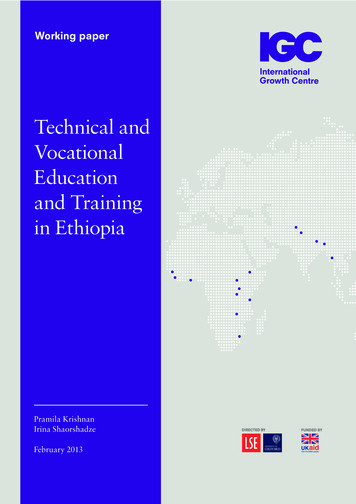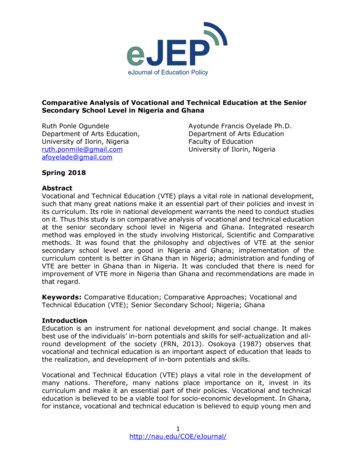
Transcription
Working paperTechnical andVocationalEducationand Trainingin EthiopiaPramila KrishnanIrina ShaorshadzeFebruary 2013
Technical and Vocational Education and Training in EthiopiaPaper for the International Growth Centre – Ethiopia Country ProgrammeIrina Shaorshadze and Pramila Krishnan1December 2012AbstractThis report presents a background study of the state of Technical and Vocational Education and Trainingin Ethiopia. We discuss the state of TVET in Ethiopia, as well as the contextual information on educationsystem and economic indicators in Ethiopia as they relate to the TVET implementation and policy. Weargue that given the supply-driven nature of the TVET system in Ethiopia, it is important to improve itsefficiency, and we propose two ways to doing this: (1) Improve efficiency and equity of the centrallydriven allocation mechanism drawing on the recent advances in matching algorithms and theirapplication to the school choice; (2) Impact evaluation of the final labour market outcomes of thegraduates has to be integral part of the TVET system, and we discuss various ways such evaluation couldbe conducted.1We would like to thank Ibrahim Worku and Alebel Bayrau Weldesilassie for the help gathering the data andinformation on TVET during our visit to Addis Ababa.1
Abbreviations and mSEDATFPTVETVETCentral Statistical AuthorityEthiopian Development Research InstituteGross Domestic ProductGross Enrolment RateInvestment Climate AssessmentLiving Standards Measurement SurveyMinistry of EducationNational Educational Assessment andExamination AgencyNet Enrolment RateNon-Governmental OrganizationNational Learning AssessmentSub-Saharan AfricaRegional Medium and Small EnterpriseDevelopment AgencyTotal Factor ProductivityTechnical and Vocational Education and TrainingVocational Education and Training2
ContentsAbbreviations and Acronyms . 21.Executive Summary . 52.Introduction and the Contextual Background . 62.1.2.1.1.TVET Policy and the Development Community Agenda . 62.1.2.German-Style Apprenticeship-based TVET system . 62.1.3.TVET in Sab-Saharan Africa . 72.1.4.Lessons from TVET Evaluations . 82.2.3.TVET Policy and it Evaluation Practices. 6Ethiopia: The Socio-Economic Context . 102.2.1.Economic Indicators in Ethiopia . 102.2.2.Education System in Ethiopia. 12TVET in Ethiopia . 133.1.TVET System in Ethiopia: Statistics . 133.2.National Exam Determining Access to the TVET Track . 153.3.TVET Fields of Study . 173.4.Apprenticeship/Job Training . 183.5.Skill Competency Assessment . 183.6.Qualifying TVET Instructors. 194.Lessons from the Efficient Mechanism Design Literature . 195.TVET Impact Policy Evaluation . 215.1.Existing Data and Tracer Studies . 215.2.Evaluation Problem: Looking for the Counterfactual . 225.3.Designing the Impact Evaluation Study . 225.3.1.Impact Evaluation Design Options . 225.3.2.Labour Market Indicators of Interest . 245.4.6.Evaluation Issues . 255.4.1.General Equilibrium Effects . 255.4.2.Displacement Effects. 26Summary . 26References . 27Appendix . 293
4
1. Executive SummaryThis report presents a background study of the state of Technical and Vocational Education and Training(TVET) in Ethiopia. The aim of the report is threefold: (1) To summarize the current state of affairs onTVET in Ethiopia in order to present the contextual information for the researchers and the donorcommunity; (2) To inform policymakers in Ethiopia on the best practices related to the impactevaluation of the TVET in terms of the final labour market outcomes of its participants, as well as on bestpractices on efficient design of school-choice matching mechanisms; (3) To discuss options for designingand conducting TVET impact evaluation in Ethiopia.The TVET system in Ethiopia is currently rapidly expanding. The government believes that the presentlow factor productivity is due to the skill gap, and that left to its own, the industry will provide lesstraining than is socially optimal. Therefore, publicly provided vocational education is seen by thegovernment as the means to close this skill gap. The government of Ethiopia looks at the public TVET asthe key in improving the productivity of the enterprises and increasing their competitiveness in theglobal market.Government involvement goes beyond mere provision of TVET. The Ministry of Education administersthe centralized exam at the end of the primary school, and scores on this exam determine if a studentcontinues to the preparatory school or is placed in the TVET track. This national exam also determineswhich level of the TVET the individual can join. Furthermore, the allocation of the numbers of places forspecialization is also centrally determined. In this regard, TVET system in Ethiopia is essentiallycommand driven, even though the government recognizes the importance of ensuring the system issufficiently flexible and responsive to demands of industry.Even if the arguments for centrally directed TVET were convincing, ensuring that such a non-marketbased system improves the outcomes of its beneficiaries is challenging in practice. We take as given thesupply-driven nature of the TVET in Ethiopia. We argue that the supply-driven nature to TVET calls formechanisms that would improve its efficiency and evaluate its effectiveness. We identify two areas forimprovement: (1) Making the current student allocation mechanism more efficient, equitable andstrategy-proof, guided by recent advances in school choice algorithms. (2) Conducting impact evaluationof the TVET training on the final labour market outcomes of the beneficiaries. Such evaluations shouldgo beyond the tracer studies that look at the outcomes of the graduates of particular institutions, andshould attempt to answer questions of the nature: what would be the outcomes of the TVET graduatesrelative to the counterfactual of no having gone through the TVET. Getting to such counterfactual ischallenging, and we will outline a few ways that such studies can be conducted.The rest of the report is structured as follows: Section 2 presents the contextual information on theTVET systems internationally and in Sub-Saharan Africa (SSA). It also gives the relevant socioeconomicbackground on Ethiopia. Section 3 describes the TVET in Ethiopia in detail; and Section 4 presents therelevance of the recent literature on the efficient school choice algorithms for improving efficiency andequity in the TVET of Ethiopia. Section 5 discusses the design options for the TVET impact evaluation.Section 6 concludes.5
2. Introduction and the Contextual Background2.1.TVET Policy and it Evaluation Practices2.1.1. TVET Policy and the Development Community AgendaTechnical and Vocational Education and Training (TVET) provides trainees with the technical skillsapplicable for the particular trade. In practice, different types of programmes are included under theumbrella of TVET. Grubb and Ryan (1999) distinguish the following four types of programmes. (1) Preemployment VET – prepares individuals for the initial entry into the employment. The regular track ofthe TVET in Ethiopia falls under this category. (2) Upgrade training provides additional training for theemployed individuals; (3) Retraining provides the training for individuals that have lost jobs or for thosewishing to switch careers; (4) Remedial VET provides training to individuals out of the mainstreamlabour force.During the last couple decades, the World Bank's advice to developing countries seems to have beenthat basic education should be the top priority, and that public expenditure on VET should be reduced(Bennell & Segerstrom, 1998). Such advice is based on the proposition that provision and funding of VETis best left to the individuals, private enterprises and private institutions. This is justified by the fact thatthe demand-driven training systems have outperformed supply-driven systems. During the last coupledecades, the interest in TVET was also low within the donor community, partly as a result of theincreased focus towards the sectorial work. By its nature TVET is multi-sectoral and it was relativelyneglected as a result.However, TVET has recently returned to the international development policy agenda. The discourse onTVET has been reinvigorated under the following three themes. (1) During the last decade, the issue ofTVET has been linked to the topics such as the Millennium Development Goals. Under-development isoften being framed as the consequence of the lack of skills, to which TVET is cast as an obvious solution.(2) As a result of the demographic transition (i.e. decreased infant mortality and increased lifeexpectancy) many developing countries have large share of the population that is young. In thesecountries, youth unemployment is an economic and social problem and is increasingly feared to createpolitical problems. TVET is cast as a solution to these issues. (3) It was hoped that the technologicaladvances of the last couple decades and globalization would improve opportunities for all. While thesehopes have materialized for the large share of population in East Asian countries and China, many otherdeveloping countries are concerned not to “miss the boat”. TVET is cast as a tool to increasecompetitiveness of industries in these countries. TVET has certainly caught the attention of policymakersin Ethiopia who have in turn looked at alternative models of TVET provision across the world and havebeen persuaded by the German model of training. In what follows, we outline this model and examinehow it works in the Ethiopia.2.1.2. German-Style Apprenticeship-based TVET systemTVET provision in different countries differs by the amount of time spent in the classroom gaininggeneral skills, versus time spent in the enterprises gaining job-specific skills. In German-style “dual”system the theory is taught in educational institutions and practical skills are acquired through the6
apprenticeship in a company. The German system has long been admired internationally. It is typicallyobserved that such a system is correlated with lower rate of youth unemployment. This correlation neednot be because of the causal link from the type of system to the employability of the graduates, but it isoften interpreted to have such a causal link. Few countries have been able to successfully emulate theGerman system, notably Switzerland, Austria and Denmark (Piopiunik & Ryan, 2012).The challenge in implementing the dual system is that a company has to be convinced that participatingin the apprenticeship scheme is ultimately to its own benefit. In reality, the firm may resist theapprenticeship arrangement because training is expensive. Trainees need to be supervised and have tooperate expensive equipment. In addition, trainees may be poached by other employers after theygraduate. This presents a classic coordination problem, where every firm could possibly benefit if theentire labour force is more skilled as a result of the training. However every firm prefers that the trainingis done by somebody else. Therefore the total amount of training offered is less than socially optimal.Coordination problems of this type are of course at least part of the justification why separate TVETinstitutions exist, as opposed to the training being done by the employer. Institutional or publicprovision of TVET attempts to tackle this coordination problem, but cannot entirely escape it if the firmbased training is desired – the coordination problem re-emerges in a different guise.German-style dual programmes demand very strong participation by employers. In practice, Germanapprenticeship involves four major sponsoring parties – the employer, the public authority, the traineeand the trade union (Streeck, Hilbert, van kevelaer, Maier, & Wber, 1987). German apprenticeshipsystem is a descendant of the mediaeval institution of apprenticeship within the merchant guilds. Itappears that in Germany the institutions have emerged that are able to solve the coordination problemsthat are inherent in the cooperative training arrangements. For an in-depth discussion on the economicsof the apprenticeship systems, as well as the policy debate on school based versus apprenticeship basedtraining, refer to (Smith & Stromback, 2001).2.1.3. TVET in Sab-Saharan AfricaThe classic essay “The vocational school fallacy in development planning” by Phillip Foster (1965) wasbased on his work in Ghana. In this essay, he argued that vocational education in Africa was a myth. Heargued that small-scale vocational training schemes might be more fruitful if they are divorced from theformal education system. He also argued that the burden of vocational training should be borne by thegroups that demand skilled labour. The dilemma on whether to concentrate investment in generaleducation or in vocational training has persisted in many African countries ever since this seminal essay(Oketch, 2007).In 2007, the African Union drafted the Strategy to Revitalize Technical and Vocational Education andTraining in Africa (African Union, 2007). The report states that there is a fresh awareness among manyAfrican countries of the critical role that TVET plays in the national development. The objectives of thestrategy are to revitalize and modernize TVET in Africa and to transform it into mainstream activity forAfrican Youth. For the discussion on the lessons learned with implementing TVET, with particular focus7
on Africa, see Kingombe (2011). Akoojee et al (2005) present a comparative study of the TVET inSouthern Africa.2.1.4. Lessons from TVET EvaluationsDuring the last few decades, it has been increasingly common to evaluate projects and interventionsboth run by the government or NGOs. Evaluation is seen as a vehicle to ensure better accountability, aswell as a tool to improve efficiency and quantify the actual impact. VET programmes, especially theactive labour market programmes in the US were path-breaking in this increased reliance on evaluationsin general, as well as in terms of the analytical tools that were developed for this purpose.Decades of evaluations of the public training programmes in the United States, the United Kingdom, andother developed countries have shown that the returns to such programmes are very low. For thesurvey of the impact evaluation of such programmes, see for instance (Carneiro & Heckman, 2003). Bytheir nature, typical public training programmes in the US were remedial, and were targeted toindividuals especially disadvantaged in the labour market, such as long-term welfare recipients.Therefore these findings do not necessarily extend to the typical pre-employment training schemes,such as institutional TVET in Ethiopia. Still, these evaluations are informative in terms of the toolsemployed and the evaluation issues to be overcome. The discussion in the section 5 draws on thelessons learned from these evaluations.Evaluation studies in developing countries have thrown up mixed results. (Betcherman, Olivas, & Dar,2004) Summarize impact evaluations of 69 training programmes, and find that training impact in LatinAmerica are on average higher than impact in the programmes in the United States and Europe.However, most studies show that programmes the impact of these programmes on employability islimited. Below we summarize some studies that look at the return to the remedial VET training in thedeveloping countries.Attanasio et al evaluate vocational training in Colombia through a randomized intervention. Thevocational training consisted of three months of in class training, followed by three months ofon-the-job training of young people between ages 18 and 25 in the two lowest socioeconomicstrata in the population. The training was provided by the private institution that had toparticipate in the bidding process. The study found that the returns to vocational educationwere positive for women. Salaried earnings increased by 20% for women. The earningsincreased both because of increased productivity and because of increased employment. Formen, the only discernible effect of the program was shifting from the informal to formal sector(Attanasio, Kugler, & Meghir, 2011).Chong and Galdo study the effect of the quality of training in Peru. The program providedtraining to the disadvantaged young individuals aged 16 to 25, and was similar in design andimplementation to the one in Columbia. The evaluation was not randomized. Therefore thecomparison group was chosen to be the “nearest-neighbour” households located in the sameneighbourhood as the participants included in the sample. The evaluation was able to compare8
the individuals six, 12 and 18 months after the program. As a measure of quality, the study usesproxies such as class size, expenditure per trainee and variables related to the course structureand teacher characteristics. The study showed that individuals attending high-quality courseshad labour earnings 20 percentage points higher than those attending lower quality courses.The earnings gap from attending high and low quality training was higher in the medium termthan the short term (Chong & Galdo, 2006).Card et al demonstrated that a similar program in the Dominican Republic had positive butmoderate impact on the trainee’s hourly wages. They found that the returns to training wereheterogeneous, and varied by the levels of prior educational achievement and age (Card,Ibarraran, Regalia, Rosas-Shady, & Soares, 2011).Hicks et al (2011) study the Technical and Vocational Voucher Program in Kenya. The programrecruited out of school youths ranging in age from 18 to 30. The participants were drawn fromthe Kenya Life Panel Survey. Out of the individuals that applied, the random half were awardeda voucher for the vocational training, while the other half served as a control. Out of thevoucher group, half of the participants received vouchers for the private institutions, while theother half received unrestricted vouchers to be used at either private or public institutions. Inaddition, random half of the participants received the information on the actual returns to thetraining. The study is on-going, and the information on the final outcomes is not yet available(Hicks, Mbiti, & Miguel, 2011).Rigorous economic evaluations of the institutional TVET which provides pre-employment training as analternative to the higher education are rarer than evaluations of the active labour market programmesthat provide short-term training. The study by Malamud and Pop-Eleches (2006) is an exception and itexploits the policy reform conducted in Romania in 1973:The Malanud and Pop-Eleches study exploits an educational reform from 1973 in Romania,which shifted large proportion of students from vocational training to general education. It looksat the employment outcomes of the affected individuals through the 1992 Census and the 19952000 LSMS. The study finds that the men affected by the policy were significantly less likely towork in manual occupations but did not show the difference is unemployment, family income orwages. Also, men affected by the policy were more likely to marry (Malamud & Pop-Eleches,2006).The findings from evaluating the remedial employment programmes do not necessarily extend to thetypical pre-employment training schemes, such as institutional TVET in Ethiopia. Individuals participatingin the remedial programmes may be more disadvantaged than the typical student in the institutionalTVET. Returns for the disadvantaged individual may be higher, if the marginal returns to the skills arehigher for low skills levels. However, the returns to the disadvantaged individuals may also be lower, ifthese disadvantaged individuals have lower ability. Still, these evaluations are informative in terms ofthe tools employed and the evaluation issues to overcome. Discussion in the section 5 draws on thelessons learned from these evaluations.9
2.2.Ethiopia: The Socio-Economic Context2.2.1. Economic Indicators in EthiopiaWith GDP per capita at 330, Ethiopia is one of the poorest countries in Arica. However, its GDP hasbeen growing at almost double digits since 2003/2004 - its growth rate has been one of the fastest inthe continent. Agriculture represents the largest sector of the economy in Ethiopia, comprising nearly50% of GDP in 2010. Services (consisting primarily of financial intermediating, public administration andretail activities) are the second largest sector of the economy, representing 38% of GDP in 2010 (Table 21). In 2005, 80% of the labour force in Ethiopia was employed in agriculture, 13% in services, and only7% in industry (CSA, 2005). The private sector is small, largely informal, and is concentrated in theservices sector. The World Bank investment Climate Assessment finds that four out of five employedyouths work in the informal sector, defined as enterprises with less than five employees (World Bank,2009).Table 2-1 Sectors of Ethiopian Economy, 1989 – 2010, Percentage of GDP1989AgricultureIndustryOf which ManufacturingServicesSource: 4538Recently the government of Ethiopia has launched a new five year plan for 2010/11 – 2014/2015, titledthe “Growth and Transformation Plan” (Ethiopia 2010). The plan aims to achieve the MillenniumDevelopment Goals and to make Ethiopia a middle-income country by 2020-2023. The plan envisionsachieving these targets through commercialization of agriculture combined with increasedindustrialization, especially in the sugar, textile and leather industries. Reaching the GDP of a middleincome country by 2023 is an ambitious goal, as it implies achieving the GDP per capita of over 1000 in2010 dollars (from the current level of 330). Achieving this target would require the annual growth rateof 11.2% for the next 14 years (Joshi & Verspoor, 2013).The Plan for Accelerated and Sustained Development to End Poverty (PASDEP), Ethiopia’s secondpoverty reduction strategy paper, states that in order to achieve the development targets, TVET willneed to provide “relevant and demand-driven education and training that corresponds to the needs ofeconomic and social sectors for employment and self-employment”. In 2008 the government of Ethiopiapublished the National Technical and Vocational Education and Training Strategy (MOE, 2008). Thestrategy outlines how the TVET program will achieve the development goals.10
The emphasis of TVET for achieving the development goals is motivated by the fact that the labourproductivity in Ethiopia is very low, even as the domestic wages are about one third of the average wagein Sub-Saharan Africa. The World Bank Investment Climate Assessment (ICA) found that measured interms of annual sales per worker, average labour productivity in Ethiopia in industries of significantpresence is less than half of the average for the SSA Countries, and even smaller fraction of that of thelow income country group. Part of the reason for the low productivity is the fact that the enterprises(i.e. factories) are not as well equipped. As a reference, the value of equipment and machinery perworker in Ethiopia in 2006, was 30% lower than the low income country average, and 50% lower thanthe SSA average. However, the ICA finds that the labour productivity in Ethiopia would still be lowerthan the comparison countries, even if its industries were equally capital intensive. The reasons for thisare lower workforce skills and higher technical inefficiencies at the enterprise level. (World Bank, 2009).Skills in Ethiopia command a higher wage premium than most developing countries. The average wagedifferential between skilled and unskilled labour is 81% in Ethiopia, compared to 14% in China. Onaverage, labour efficiency in medium and large firms in Ethiopia is about 50% of that in similar sizedfirms in China. In small and micro enterprises, labour productivity is less than 20% of the Chinese level(Dinh, Palmade, Chandra, & Cossar, 2012).In 2006/2007, the Ethiopian Development Research Institute (EDRI) with the technical assistance of theWorld Bank conducted the Productivity and Investment Climate Survey. The survey included 600 firmsbased in urban areas (124 firms in trade and services, 360 manufacturing enterprises and 126 microenterprises). The World Bank Ethiopia Investment Climate Assessment based on this survey found thatthe large proportion of medium and large firms state that worker skills are a severe or very severeconstraint on business (Table 2-2) (World Bank, 2009). We now proceed to summarizing the state of theeducation system in Ethiopia to help shed light on the origins of the skill deficit.Table 2-2 Ethiopian Firms that Find Worker Skills a Severe or Very Severe Constraint on BusinessServicesEthiopia as a WholeType of FirmSmallMediumLargeDomesticWith Foreign InvestmentNon-exportingExportingSource: (World Bank, 11
2.2.2. Education System in EthiopiaThrough most of the twentieth century, Ethiopia was one of the most disadvantaged countries in termsof access to education. As a legacy, in 2008, the literacy rate in Ethiopia was estimated to be 36%, andthe average educational attainment of the population 15 years or older was an astonishing 1.5 years(EdStats). School enrolment has expanding rapidly in recent decades. By 2010, there was near universalaccess to the first cycle of the primary education, but only half of the relevant group was enrolled in thesecond cycle (Table 2-3) (Joshi & Verspoor, 2013).Table 2-3 Participation Rates in Education by Grade Level, 834.938.416.411-129.67.18.4NAHigher Education8.43.66.3NASource: Education Statistics Annual Abstract, 2010/11 (MOE, 2010)Note: GER Gross Enrolment Rate, NER Net Enrolment rate, NA Not AvailableNERFemaleAll89.447.983.516.2NANAThe structure of the education system in Ethiopia is as follows. Primary education (grades 1-8) aims toprovide the basic literacy and numeracy skills. General secondary education (grades 9-10) aims to enablestudents to identify areas of interest for further education and training. The preparatory level (grades 11and 12) prepares the student for the higher education or careers. National examinations areadministered at the end of grade 10 and 12. According to the officials of the MOE, approximately 30% ofstudents that reach 10th grade will continue to higher education. The rest of the students will eitherenrol in TVET, or leave the formal education system.Technical and vocational education (TVET) is institutionally separate from the rest of the educationsystem, and forms a parallel track. Students entering TVET stream after completing grade 10, have threeoptions open to them, depending on the score received in the national exam: (1) one year training(10 1); 2 year training (10 2), or three
the demand-driven training systems have outperformed supply-driven systems. During the last couple decades, the interest in TVET was also low within the donor community, partly as a result of the increased focus towards the sectorial work. By its nature TVET is multi-sectoral and it was relatively neglected as a result.











